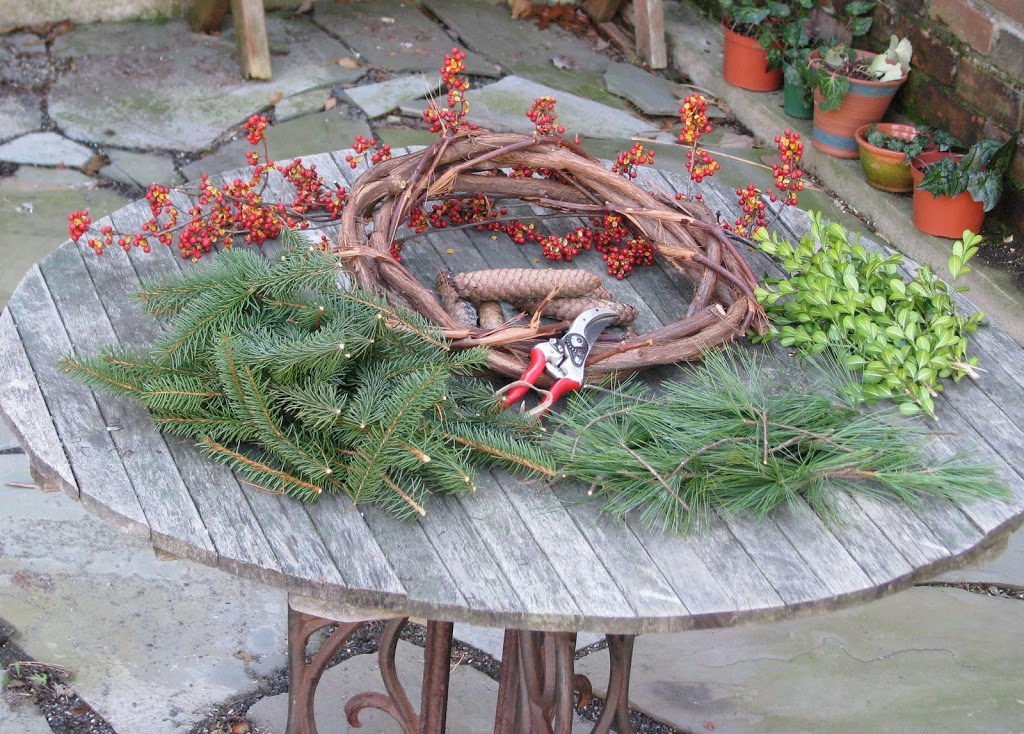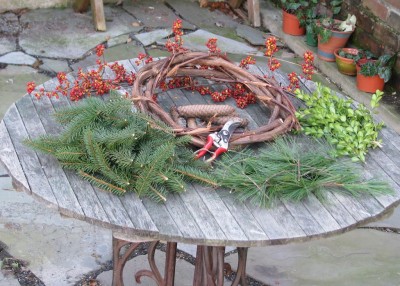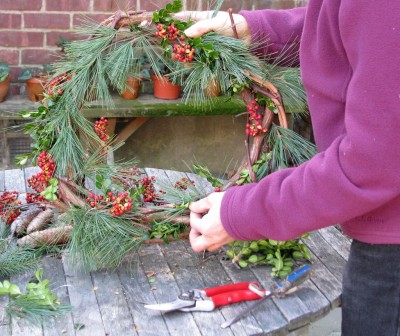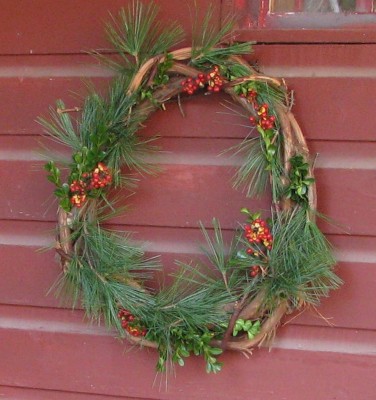HOMEGROWN WREATH
The dark green wreath was tied with red ribbons and gliding towards me, in its progress stirring up snowflakes gently floating out of the grey sky. No, the wreath was not hanging from a horse-drawn sled, but was plowing through the frigid air affixed to the chrome grille of a gleaming white Cadillac! Here we are in the twenty-first century, still infusing a breath of life into our winters with cut evergreen boughs, just as did the ancient Egyptians, Persians, Jews, Christians, and Druids.
And it’s true: a few evergreen boughs tied together and accented with a red ribbon do make a doorway more inviting, or a room more cozy in winter. (I’m still undecided about what greenery does for a Cadillac grill.) But going one step further with the greenery, to a bona fide wreath, creates something special. And the actual making of a wreath can be an end in itself this time of year, particularly to the accompaniment of a warm fire and friends and children.
To make a wreath, start with a base. The base might be a sturdy ring of wire (from a coat hanger, for example), or straw that has been bound into a bulky circle with string. Either of these bases can be made from scratch or purchased. For a more natural base, one which might be part of the final design, use a vine such as grape, honeysuckle, wisteria, or bower actinidia. Weave the vine into a circle of triple thickness, tucking in a new piece of vine as an old one ends.
The base might be all, or just about all, that is needed for a simple wreath. I have seen a very attractive wreath that was nothing more than a thick ring of wild rose sprigs showing off a profusion of pastel red fruits. Carefully overlapped sprigs of lavender or rosemary, bound with thin wire to a heavier wire frame, make a dainty, fragrant, blue-green wreath. Thyme is another good plant for this purpose, also fragrant. Keep thyme’s wiry stems somewhat loose, though, because they are as important in adding body to the wreath as are the tiny leaves.
This time of year my penchant is for wreaths that are rich green in color, and almost gaudy with ornamentation. The base for such wreaths is some evergreen plant. Not all evergreens are suitable, because some drop their leaves too readily indoors (and in the brisk wind riding on the front of a car!). Amongst needle-leaf evergreens, juniper, white pine, mugho pine, red pine, and spruce are good choices. Or, for something brighter, needled evergreens with yellow-tipped leaves, such as Gold Star and Kuriwao Sunburst junipers. Mahonia, holly, leucothoe, rhododendron, boxwood, lingonberry, and English ivy are suitable broad-leaf evergreens for a wreath, but none of the broadleaf evergreens will hold their leaves indoors as long as the needle-leaved evergreens.
Wire, glue or tuck small bunches of evergreens onto the base, with all the bunches facing the same direction. Don’t be stingy, because this mass of green color is what is going to calm down and visually hold together the whole wreath.
Next, add accent. Ornaments that are darker shades, and blue or green, make a quieter wreath than ornaments that are lighter shades, and red or yellow. As I said, this time of year I prefer spirited ornamentation, perhaps due to the impending dead of winter. Lively ornaments might include chains of shiny red cranberries or popcorn threaded together, bunches of bright red peppers and garlic clove.
Fruits, like evergreen leaves, flaunt winter’s cold darkness to celebrate the continuity of life from one year to the next. Some brightly colored fruits still clinging to vines and shrubs include mountainash, bittersweet, winterberry, barberry, and, of course, holly. Deck the halls.






Leave a Reply
Want to join the discussion?Feel free to contribute!